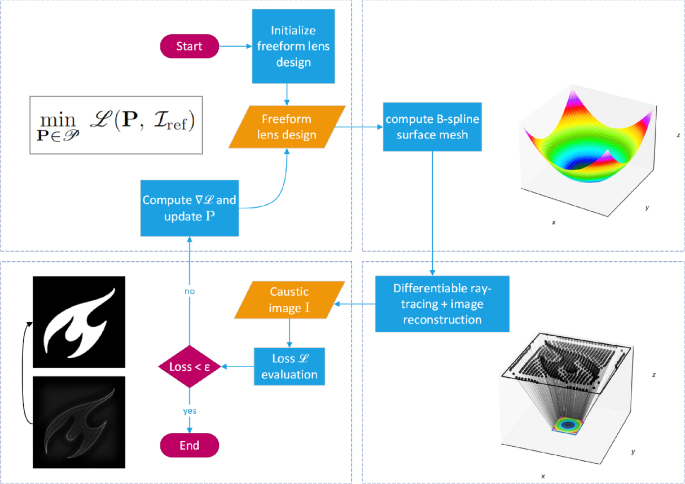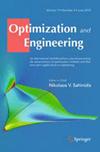Gradient descent-based freeform optics design for illumination using algorithmic differentiable non-sequential ray tracing
IF 1.7
3区 工程技术
Q2 ENGINEERING, MULTIDISCIPLINARY
引用次数: 1
Abstract
Abstract Algorithmic differentiable ray tracing is a new paradigm that allows one to solve the forward problem of how light propagates through an optical system while obtaining gradients of the simulation results with respect to parameters specifying the optical system. Specifically, the use of algorithmically differentiable non-sequential ray tracing provides an opportunity in the field of illumination engineering to design complex optical system. We demonstrate its potential by designing freeform lenses that project a prescribed irradiance distribution onto a plane. The challenge consists in finding a suitable surface geometry of the lens so that the light emitted by a light source is redistributed into a desired irradiance distribution. We discuss the crucial steps allowing the non-sequential ray tracer to be differentiable. The obtained gradients are used to optimize the geometry of the freeform, and we investigate the effectiveness of adding a multi-layer perceptron neural network to the optimization that outputs parameters defining the freeform lens. Lenses are designed for various sources such as collimated beams or point sources, and finally, a grid of point sources approximating an extended source. The obtained lens designs are finally validated using the commercial non-sequential ray tracer LightTools.

基于梯度下降的自由光学照明设计,采用算法可微的非顺序光线追踪
摘要算法可微光线追踪是一种新的研究范式,它允许人们解决光如何在光学系统中传播的正向问题,同时获得模拟结果相对于指定光学系统参数的梯度。具体来说,使用算法可微的非顺序光线跟踪为照明工程领域设计复杂的光学系统提供了机会。我们通过设计将规定的辐照度分布投射到平面上的自由曲面透镜来展示其潜力。挑战在于找到合适的透镜表面几何形状,使光源发出的光重新分布到所需的辐照度分布中。我们讨论了关键步骤,使非顺序射线跟踪器是可微的。获得的梯度用于优化自由曲面的几何形状,并研究了在优化中添加多层感知器神经网络的有效性,该网络输出定义自由曲面透镜的参数。透镜设计用于各种光源,如准直光束或点源,最后,点源的网格近似扩展源。最后使用商用非顺序光线追踪器LightTools验证获得的透镜设计。
本文章由计算机程序翻译,如有差异,请以英文原文为准。
求助全文
约1分钟内获得全文
求助全文
来源期刊

Optimization and Engineering
工程技术-工程:综合
CiteScore
4.80
自引率
14.30%
发文量
73
审稿时长
>12 weeks
期刊介绍:
Optimization and Engineering is a multidisciplinary journal; its primary goal is to promote the application of optimization methods in the general area of engineering sciences. We expect submissions to OPTE not only to make a significant optimization contribution but also to impact a specific engineering application.
Topics of Interest:
-Optimization: All methods and algorithms of mathematical optimization, including blackbox and derivative-free optimization, continuous optimization, discrete optimization, global optimization, linear and conic optimization, multiobjective optimization, PDE-constrained optimization & control, and stochastic optimization. Numerical and implementation issues, optimization software, benchmarking, and case studies.
-Engineering Sciences: Aerospace engineering, biomedical engineering, chemical & process engineering, civil, environmental, & architectural engineering, electrical engineering, financial engineering, geosciences, healthcare engineering, industrial & systems engineering, mechanical engineering & MDO, and robotics.
 求助内容:
求助内容: 应助结果提醒方式:
应助结果提醒方式:


